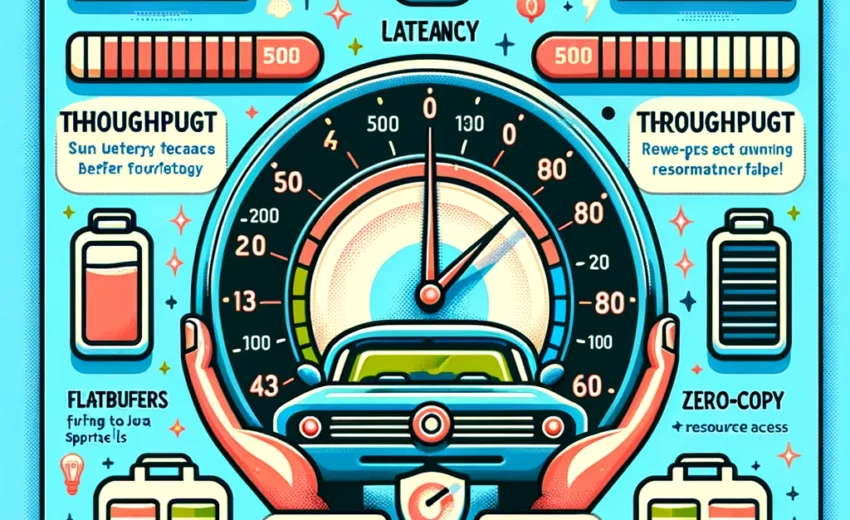
gRPC x FlatBuffers
Comparing gRPC with FlatBuffers directly is a bit like comparing apples with oranges, because they serve slightly different purposes, although they can both be used in interprocess communication (IPC) systems and networks.
gRPC is a high-performance remote procedure call (RPC) framework that uses HTTP/2 for communication and Protocol Buffers as its data serialization mechanism by default. gRPC is designed for peer-to-peer connections and offers functionality such as bidirectional streaming, load balancing, tracing, integrity checking, and authentication.
FlatBuffers, on the other hand, is an efficient data serialization system designed to be fast and efficient, allowing data to be read without parsing or unpacking, which is known as “zero-copy” access. It was designed for use in games, real-time systems and other applications where reading performance is critical.
Was it complicated? Let’s bring some analogies to the real world:
The Metaphor of High-Tech Vehicles
When we explore the vast world of interprocess communication, we come across two notable technologies: gRPC and FlatBuffers. Imagine gRPC as a high-speed train, designed for long journeys with all modern amenities — a perfect choice for complex, high-load communications. In contrast, FlatBuffers resembles an agile sports car, optimized for immediate acceleration and efficiency, ideal for short races where every millisecond counts.
The Online Gaming Arena
In the exciting world of online gaming, where latency can be the divider between victory and defeat, FlatBuffers shines brightly. Imagine a virtual world where every action and movement is transmitted with millimeter precision, without delays. Here, FlatBuffers allow game states and character positions to be read directly from memory without the need for unwrapping, ensuring a fluid and responsive gaming experience.
Revolutionizing E-commerce
Meanwhile, in the dynamic e-commerce sector, gRPC takes on the role of maestro, masterfully orchestrating secure transactions and communications between microservices. But when it comes to displaying the vast product catalog to users, FlatBuffers comes into play, significantly reducing loading times and elevating the user experience to new heights.
Is it clearer? So when can one be faster than the other?
Serialization/Deserialization
FlatBuffers can be faster than Protocol Buffers (the gRPC standard) for reading data, as the data can be accessed directly without an unpacking step. This can make it faster in scenarios where efficiently reading data is critical.
Network Communication
gRPC, using HTTP/2, can be more efficient in terms of network communication than an approach based solely on FlatBuffers transmitted over a simpler protocol such as HTTP/1.1. HTTP/2 offers advantages such as stream multiplexing, header compression, and flow control, which can make communication more efficient.
High Level Features
gRPC offers high-level functionality such as streaming, flow control, and call cancellation, which can be critical for certain applications and impact overall performance by reducing the amount of data transmitted or handling real-time communications more effectively.
Using FlatBuffers with gRPC
It is important to note that you can use FlatBuffers as a serialization mechanism within gRPC, thus combining the advantages of gRPC in terms of communication and those of FlatBuffers in terms of serialization/deserialization efficiency. This combination can provide superior performance in many scenarios compared to using gRPC with Protocol Buffers or FlatBuffers alone.
The choice between gRPC and FlatBuffers (or a combination of both) should be based on your project’s specific performance, functionality, and development complexity needs. Performing benchmarks specific to your use case can help determine the best choice for your situation.
To demonstrate a complex example that uses both gRPC and FlatBuffers, let’s create a scenario where we implement an inventory management service. This service will allow you to add products to the inventory and list all available products.
We will use gRPC to define and implement service communication and FlatBuffers for efficient data serialization.
Step 1: Defining the FlatBuffers Schema
First, we define the FlatBuffers schemas for our products and product list.
// inventory.fbs
namespace Inventory;
table Product {
id: int;
name:string;
price:float;
inStock:bool;
}
table ProductList {
products:[Product];
}
root_type ProductList;
Step 2: Compilation of FlatBuffers Schemas
We use the flatc compiler to generate the necessary code bindings from our FlatBuffers schema.
flatc --java inventory.fbs
Step 3: Defining gRPC Services
Now we define our gRPC service in the .proto file. Note that even though we are using FlatBuffers, we still need to define the service structure in a .proto file for gRPC.
// inventory.proto
syntax = "proto3";
package inventory;
service InventoryService {
rpc AddProduct (Product) returns (AddProductResponse);
rpc ListProducts (ListProductsRequest) returns (ProductList);
}
message AddProductResponse {
bool success = 1;
}
message ListProductsRequest {}
We generate the code stubs needed for gRPC from the .proto file.
protoc --java_out=. --grpc-java_out=. inventory.proto
Step 5: Implementation of the gRPC Server with FlatBuffers
We implemented the gRPC server in Java, using FlatBuffers bindings for data serialization.
package inventory;
import io.grpc.Server;
import io.grpc.ServerBuilder;
import io.grpc.stub.StreamObserver;
import com.google.flatbuffers.FlatBufferBuilder;
public class InventoryServer {
private Server server;
private void start() throws IOException {
int port = 50051;
server = ServerBuilder.forPort(port)
.addService(new InventoryServiceImpl())
.build()
.start();
Runtime.getRuntime().addShutdownHook(new Thread(() -> {
System.err.println("*** shutting down gRPC server since JVM is shutting down");
InventoryServer.this.stop();
System.err.println("*** server shut down");
}));
}
private void stop() {
if (server != null) {
server.shutdown();
}
}
private static class InventoryServiceImpl extends InventoryServiceGrpc.InventoryServiceImplBase {
@Override
public void addProduct(Product request, StreamObserver responseObserver) {
// Implement logic to add product using FlatBuffers
AddProductResponse response = AddProductResponse.newBuilder().setSuccess(true).build();
responseObserver.onNext(response);
responseObserver.onCompleted();
}
@Override
public void listProducts(ListProductsRequest request, StreamObserver responseObserver) {
// Implement logic to list products using FlatBuffers
FlatBufferBuilder builder = new FlatBufferBuilder(0);
// Suppose we have a method that builds a list of products
int productList = createProductList(builder);
builder.finish(productList);
byte[] byteArray = builder.sizedByteArray();
// Here you will need to convert byteArray to ProductList gRPC response
// This may require defining a utility method to convert between FlatBuffer byte array and gRPC objects
responseObserver.onCompleted();
}
}
public static void main(String[] args) throws IOException, InterruptedException {
final InventoryServer server = new InventoryServer();
server.start();
server.blockUntilShutdown();
}
}
Step 6: Implementation of the gRPC Client
Implement gRPC client that communicates with the server to add and list products.
package inventory;
import io.grpc.ManagedChannel;
import io.grpc.ManagedChannelBuilder;
public class InventoryClient {
private final InventoryServiceGrpc.InventoryServiceBlockingStub blockingStub;
public InventoryClient(ManagedChannel channel) {
blockingStub = InventoryServiceGrpc.newBlockingStub(channel);
}
public void addProduct() {
// Build the product using FlatBuffers
// Call the gRPC addProduct method
}
public void listProducts() {
// Call the gRPC listProducts method
// Convert the response
ListProductsRequest request = ListProductsRequest.newBuilder().build();
ProductList response = blockingStub.listProducts(request);
// Here you will need to convert the ProductList response from gRPC
// to format FlatBuffers for processing.
// This may involve deserializing the FlatBuffers payload within the gRPC response.
// Suppose we have a method to deserialize and print the products
printProductList(response);
}
private void printProductList(ProductList productList) {
// Deserialize the FlatBuffers product list and print
// Assume 'productListByteArray' is the byte array of FlatBuffers obtained from the gRPC response
ByteBuffer bb = ByteBuffer.wrap(productListByteArray);
Inventory.ProductList fbProductList = Inventory.ProductList.getRootAsProductList(bb);
for (int i = 0; i < fbProductList.productsLength(); i++) {
Inventory.Product product = fbProductList.products(i);
System.out.println("Product ID: " + product.id() + ", Name: " + product.name() + ", Price: " + product.price() + ", In Stock: " + product.inStock());
}
}
public static void main(String[] args) throws Exception {
// Assume "localhost" and "50051" are the address and port of the gRPC server
String target = "localhost:50051";
ManagedChannel channel = ManagedChannelBuilder.forTarget(target)
.usePlaintext() // Disables SSL to avoid the need for certificates.
.build();
try {
InventoryClient client = new InventoryClient(channel);
client.addProduct();
client.listProducts();
} finally {
channel.shutdownNow().awaitTermination(5, TimeUnit.SECONDS);
}
}
}
In this example, the gRPC client communicates with the server to perform inventory operations. When the listProducts method is called, it sends a request to the server, which responds with a list of products serialized using FlatBuffers. The client then deserializes this response using the defined FlatBuffers schema and prints the products details.
Comments
Conversion between gRPC and FlatBuffers: This example assumes that you have methods to convert between the gRPC data format and the FlatBuffers serialization format. In practice, you will need to implement this conversion logic, which may involve working directly with byte arrays and the FlatBuffers API to build or read data structures.
Exception Handling
Exception handling is not shown in this example, but it is important to implement it correctly on both the client and server sides to handle possible network errors, serialization issues, etc.
Security
For simplicity, SSL/TLS has been disabled in the gRPC client (usePlaintext()). In a production environment, you must enable and configure appropriate security to protect communication between the client and the server.
This example illustrates how to combine gRPC and FlatBuffers to create an efficient inventory management system, taking advantage of both: the robust communication and functionalities of gRPC, along with the efficient data serialization of FlatBuffers.





